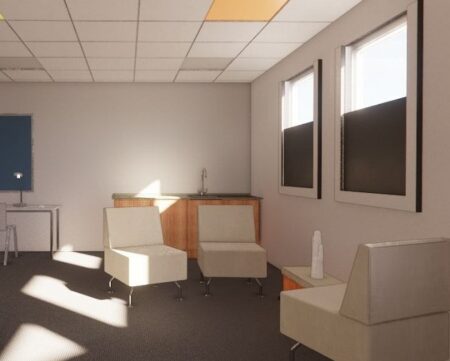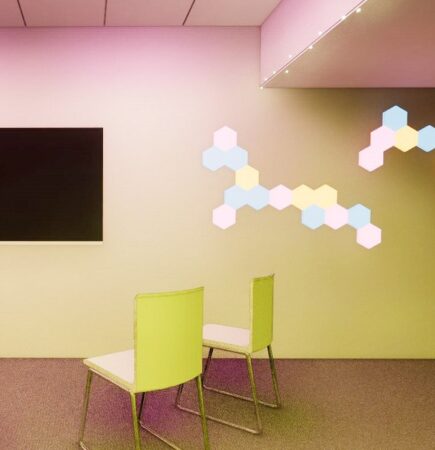Let there be light!
New research is revealing the impact of lighting design on SEND school pupils

Over recent years there has been an increased focus on research into how the design of educational establishments can impact on learning behaviours and outcomes.
But one element which is often overlooked is lighting.
A study of 21,000 elementary students in the US in 2009 showed that, over one academic year, children who were exposed to more sunlight during the school day displayed 26% higher reading outcomes and 20% higher maths outcomes than those in less-sunny classrooms.
In the UK, however, little research has been carried out and the Department for Education’s (DfE’s) Lighting Guidance 5: Lighting for Education document, which is the go-to for designers, has not been updated since 2011.
To address this shortfall in evidence, University College London (UCL) has collaborated with Dr Shelley James, an international expert on light and wellbeing at Age of Light Innovations; architectural practices, Haverstock and Noviun Architects; and The Hawthorns School and Yeoman Park Academy to ascertain the general awareness of the importance of lighting and find simple, affordable retrofit solutions that could be applied to spaces to enhance the learning and wellbeing of pupils with special educational needs and disabilities (SEND).

Window screening can reduce distraction from outside while still bringing daylight into the room
Taking control
Speaking to Education Property, Dr James said: “The school output specification – Lighting Guide 5 – was published more than a decade ago and is based on nine light fittings in a grid with little or no option for control – the lights are either on, or they are off!
“There really is a need to make sure that our teaching environments are appropriate and allow pupils to flourish.”
The research centred on SEND schools as there has been little academic focus on these very-specialised environments, and particularly on the impact of lighting on neurodivergent pupils.
However, previous research has found that 54% of children with autism struggle with visual discomfort in the classroom and this is directly linked to poor concentration, anxiety, headaches, and behaviour issues.
SEND pupils also struggle with getting a good night’s sleep and this has a knock-on effect on their learning.
Dr James explains: “Lighting can improve sleep. Research has found that children exposed to brighter morning light fell asleep earlier that day, woke earlier the following day, and went to sleep earlier that night too.

The study looked at how different
lighting solutions could be used
in different areas of the classroom
Self regulating
“If children spend the day in 300 lux lighting conditions, which is recommended in classrooms, then go home to a computer or TV, they live in a kind of twilight zone and their body clocks start to free run, with disastrous consequences.
“Variable light, therefore, is hugely important to help students self regulate.
“When we give teachers lighting controls as part of the tools they can use, we see some extraordinary results.”
The first phase of the collaborative research concentrated on teachers’ awareness of the impact lighting can have on pupils’ concentration and learning in two SEND schools and what research already exists into the impact of various solutions.
To further teachers’ awareness, the first phase used simple retrofit solutions to ascertain what might benefit the pupils the most.
And it is hoped that, while the study has concentrated on SEND schools, it will have wider ramifications for mainstream settings in the future to assist neurodiverse pupils.

A cosy corner within the main classroom uses twinkling lights and a reduced ceiling height to provide an intimate sensory space
True colours
For the first phase of the research, the team sourced low-cost, retrofit lighting devices, including coloured films for the windows to help regulate daylight and improve circadian rhythm; colour-changing panels and LED strips, which were placed around noticeboards and in corridors; fairylights; and interactive wall tiles. There was also a small colour-changing chick which was one of the most-popular interventions among both staff and pupils, helping to signify mood and to calm pupils, which worked particularly well for non-verbal pupils.
The coloured LED lights could be altered to reflects the days of the week and time of day, helping to maintain all-important circadian rhythms. The schools also found standard tracing paper on the windows was also effective.
Pupils, in particular, had fun with the colour-changing light strips and verbal and non-verbal pupils used the interactive chick to display mood and to help them self regulate.

The main learning space in the centre of the classroom uses grid ceiling lights that can change colour tone throughout the day to work with children’s circadian rhythm
Knowing better
But, key to their success at both schools was the element of control, enabling both teachers and pupils to vary light levels and colour at particular points in the day or for specific tasks.
Dr James said: “Traditional school lighting solutions are not designed relative to how we teach. The teacher might be standing at the front of the room and the children can’t see them!
“Many of us have smart lighting in our homes and yet we are still using gridded ceilings with standard light fittings in our schools. Why are we still doing that knowing what we know?”
Zane Putne, SEND director at Noviun Architects, adds: “Lighting controls do not really exist at the moment in schools. We are keen to find potential solutions, not just to make future schools better, but also to find retrofit solutions for existing buildings.
“Pupils with ADHD and autism, for example, can be more affected by extreme colour contrast and glare and this impacts on their ability to cope and concentrate at school, which is already a stressful place for many.
“SEND schools use different spaces for different things and it is important that lighting can be controlled within these spaces to create zones for various activities.”

Interactive lights and coloured ceiling grid lights draw attention to, and maintain focus on, the main teaching wall
Beyond compliance
With schools on strict budgets, the researched focused on lighting solutions which were flexible; able to be retrofitted into existing, often outdated, buildings; and which were affordable and sustainable.
Dr James said: “Even though the lighting complied with current regulations, teachers were clear that the legal minimum is not sufficient for them to support their students effectively, especially the ability to adjust colour temperature and brightness for different activities across the day.
“Compliance is not enough.
“Building standards for modern workplaces reflect new knowledge and support diversity, but education is falling behind.
“Simple, affordable retrofit solutions have clear potential to improve outcomes and teacher satisfaction and teaching teams are ready to invest and make the effort – if they understand why.”
The team is now taking the findings from phase 1 of the study to inform the next stage, which will run from September to March and will explore more-permanent lighting solutions across a larger number of schools.
Putne said: “We need to be pragmatic and focus on retrofit solutions within tight budgets.
A game-changer
“During the second phase we will work with the Building Research Establishment (BRE) and lighting specialists to continue our research , concentrating on how we can evaluate the results and how to integrate elements of lighting into every school.
“We will look at how learning spaces are used in real life and how each space within a classroom can use lighting in a way that supports pupils and teachers and the function of that space.
“What we want to produce is a kit of parts that can be put in any school.”
Anna Monaghan, an associate at Haverstock, adds: “Currently many schools are in temporary accommodation or older buildings. If we can make lighting work here, then we can do it anywhere. This research could be a game changer for all.
“Schools have limited space, so we need to look at how rooms can be split up and how lighting and lighting controls can be incorporated into these rooms to perform for lots of different activities.”
